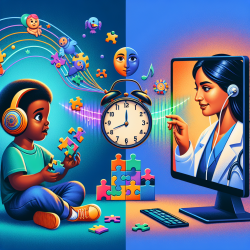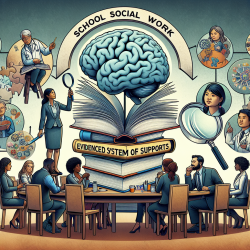Introduction
In the realm of speech-language pathology, data-driven decisions are pivotal in creating effective interventions for children, especially those with Autism Spectrum Disorder (ASD). The research article "Current Trends in Telehealth Applications to Deliver Social Communication Interventions for Young Children with or at Risk for Autism Spectrum Disorder" provides a comprehensive overview of how telehealth is reshaping early intervention practices. This blog aims to distill key findings from the research and offer actionable insights for practitioners eager to improve their skills and outcomes for children with ASD.
The Power of Telehealth in ASD Interventions
Telehealth, the use of telecommunications technology to deliver healthcare services, has gained significant traction in recent years. The COVID-19 pandemic accelerated its adoption, offering a timely solution to the barriers many children face in accessing early interventions. The research highlights that telehealth can effectively increase access to interventions, overcoming geographical and financial barriers.
Key Findings from the Research
- Synchronous Telehealth: This live interaction method is the most frequently used, allowing real-time feedback and consultation, which is crucial for maintaining intervention fidelity.
- Asynchronous Telehealth: Though less common, this method provides flexibility, allowing caregivers to record sessions at convenient times and tele-providers to review them later.
- Online Learning Modules: These are often used in conjunction with telehealth to provide foundational knowledge and skills to parents and caregivers.
Practical Recommendations for Practitioners
For practitioners new to telehealth, the research offers several recommendations:
- Family-Centered Approach: Engage families in the intervention process, ensuring that strategies are tailored to their routines and needs.
- Technology Preparation: Assist families in setting up and troubleshooting technology to ensure smooth telehealth sessions.
- Interactive Training: Use a combination of live coaching and asynchronous feedback to enhance parent and caregiver skills.
Future Directions and Opportunities
The research suggests that telehealth is not a replacement for in-person interventions but a powerful supplement that can enhance service delivery. Future research should focus on integrating telehealth into existing models to optimize outcomes and explore its cost-effectiveness. Moreover, emerging technologies like virtual reality and remote monitoring hold promise for further innovation in this field.
Conclusion
Telehealth represents a transformative approach to delivering social communication interventions for children with ASD. By embracing these technologies, practitioners can expand their reach, improve access to services, and ultimately create better outcomes for children. As we continue to explore and refine these methods, the potential for positive change is immense.
To read the original research paper, please follow this link: Current Trends in Telehealth Applications to Deliver Social Communication Interventions for Young Children with or at Risk for Autism Spectrum Disorder.










